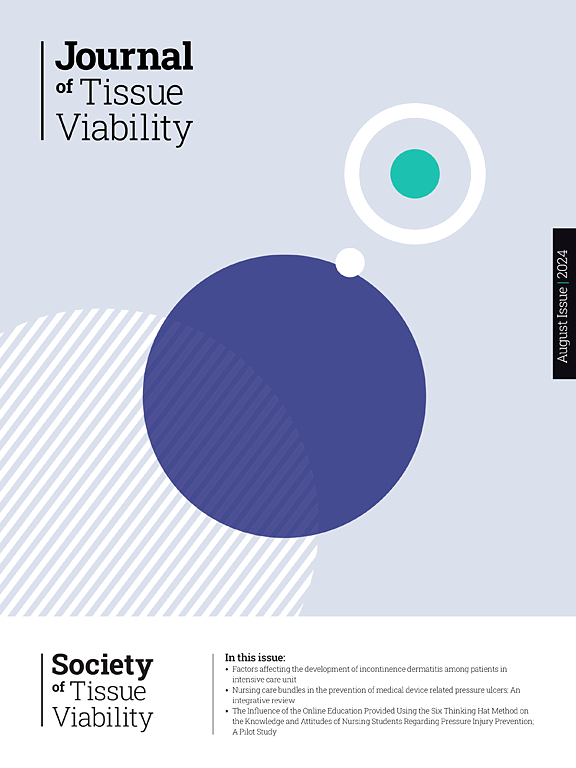表面之外的愈合:移情在慢性伤口护理中的作用:一项定性研究
IF 2.4
3区 医学
Q2 DERMATOLOGY
引用次数: 0
摘要
目的本研究旨在探讨卫生专业人员对共情对愈合结果、患者满意度和伤口护理交付的影响的看法。材料和方法采用描述性定性方法,对澳大利亚10名专门从事伤口护理的医疗保健专业人员进行半结构化面对面访谈。参与者有目的地抽样,访谈持续22到47分钟。数据收集在达到饱和时结束。使用CORV(一种安全的转录工具)逐字转录访谈内容,并使用Braun和Clarke的六阶段主题框架进行分析。通过采用COREQ指南、三角数据分析和包括直接引用以确认性来确保严谨性。结果共情作为信任、参与和协作的基础,参与者强调共情促进信任,提高患者依从性,并使治疗目标一致。(2)共情在解决心理和生理障碍方面的双重作用,共情治疗减轻了心理困扰,建立了复原力,提高了对治疗方案的依从性。(3)伤口护理中共情的障碍和促进因素,时间限制、情绪疲劳和文化差异被认为是障碍,而指导、培训和支持性环境则有助于共情护理。结论卫生专业人员认为共情是提高患者满意度和支持伤口治疗结果的关键因素。通过提供信任,解决情感障碍,使护理与患者需求保持一致,共情在护理过程中发挥着有意义的作用。此外,解决系统障碍和深思熟虑地将移情训练纳入临床实践有助于改善慢性伤口管理的结果。本文章由计算机程序翻译,如有差异,请以英文原文为准。
Healing beyond the surface: Empathy's role in chronic wound care a qualitative study
Aim
This study aimed to investigate health professionals’ perceptions of the impact of empathy on healing outcomes, patient satisfaction and delivery of wound care.
Materials and methods
A descriptive qualitative approach was used, employing semi-structured face-to-face interviews with 10 healthcare professionals specializing in wound care in Australia. Participants were purposively sampled, and interviews lasted between 22 and 47 min. Data collection concluded upon achieving saturation. Interviews were transcribed verbatim using CORV, a secured transcription tool, and analyzed using Braun and Clarke's six-phase thematic framework. Rigor was ensured by employing COREQ guidelines, triangulating data analysis, and including direct quotes for confirmability.
Results
Three key themes emerged: (1) Empathy as a Foundation for Trust, Engagement, and Collaboration where participants emphasized that empathy promotes trust, improves patient adherence, and aligns treatment goals. (2) The Dual Role of Empathy in Addressing Emotional and Physical Barriers to Healing where empathetic care alleviated psychological distress, built resilience, and improved adherence to care regimens. (3) Barriers and Facilitators to Empathy in Wound Care where time constraints, emotional fatigue, and cultural differences were identified as barriers, while mentorship, training, and supportive environments facilitated empathetic care.
Conclusion
Health professionals considered empathy to be a critical factor in enhancing patient satisfaction and supporting healing outcomes in wound care. By providing trust, addressing emotional barriers, and aligning care with patient needs, empathy plays a meaningful role in the care process. Additionally, addressing systemic barriers and thoughtfully integrating empathy training into clinical practice can contribute to improved outcomes in chronic wound management.
求助全文
通过发布文献求助,成功后即可免费获取论文全文。
去求助
来源期刊

Journal of tissue viability
DERMATOLOGY-NURSING
CiteScore
3.80
自引率
16.00%
发文量
110
审稿时长
>12 weeks
期刊介绍:
The Journal of Tissue Viability is the official publication of the Tissue Viability Society and is a quarterly journal concerned with all aspects of the occurrence and treatment of wounds, ulcers and pressure sores including patient care, pain, nutrition, wound healing, research, prevention, mobility, social problems and management.
The Journal particularly encourages papers covering skin and skin wounds but will consider articles that discuss injury in any tissue. Articles that stress the multi-professional nature of tissue viability are especially welcome. We seek to encourage new authors as well as well-established contributors to the field - one aim of the journal is to enable all participants in tissue viability to share information with colleagues.
 求助内容:
求助内容: 应助结果提醒方式:
应助结果提醒方式:


